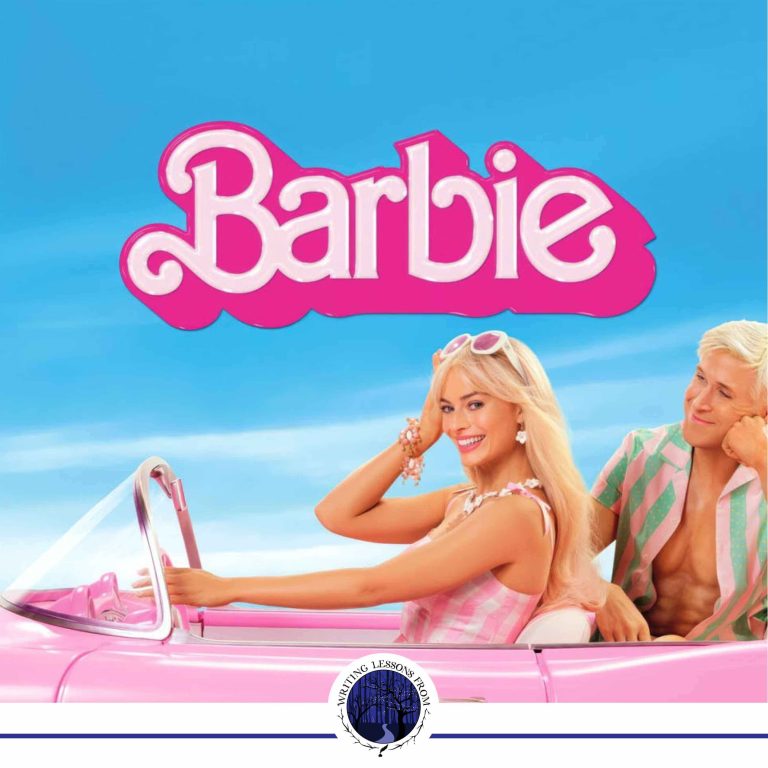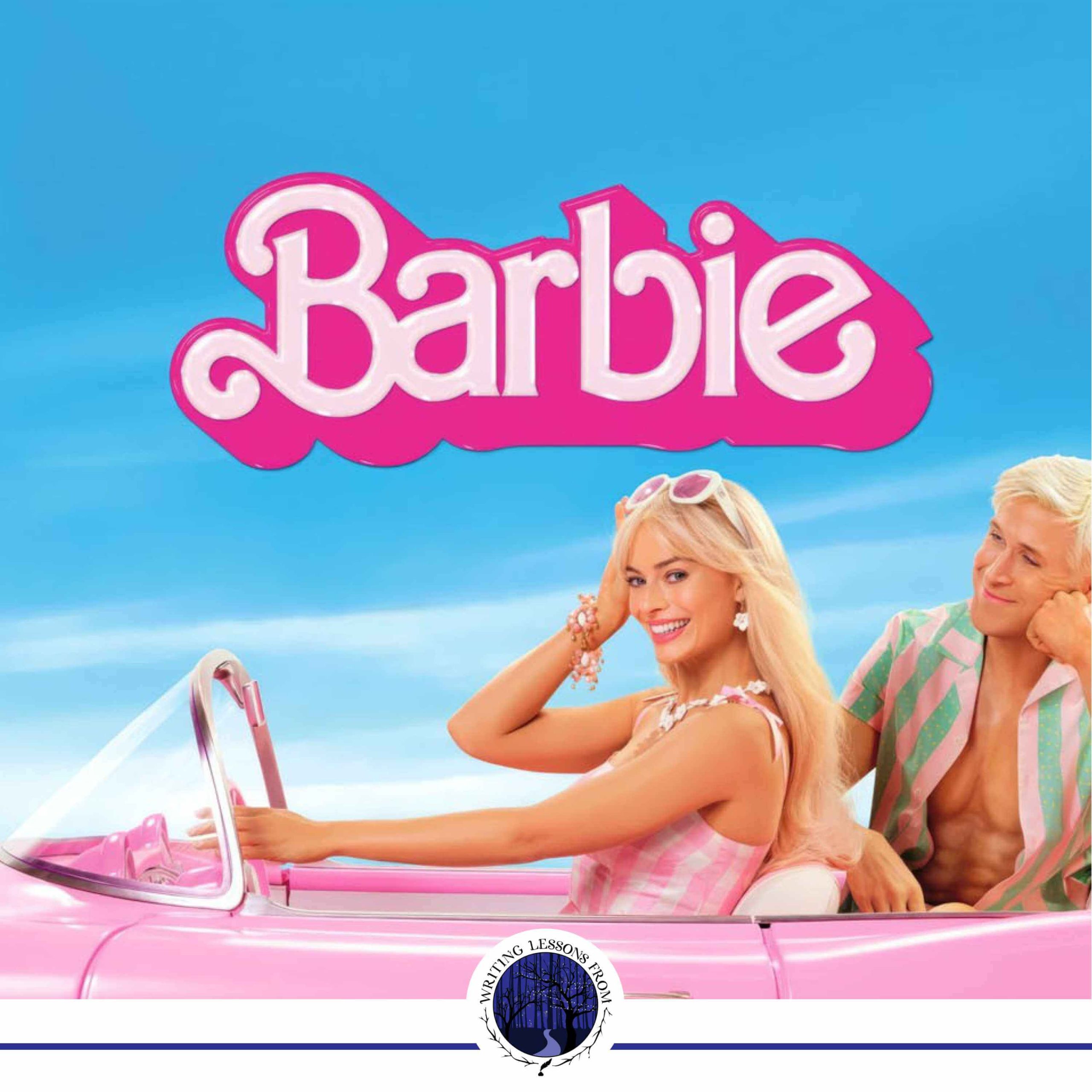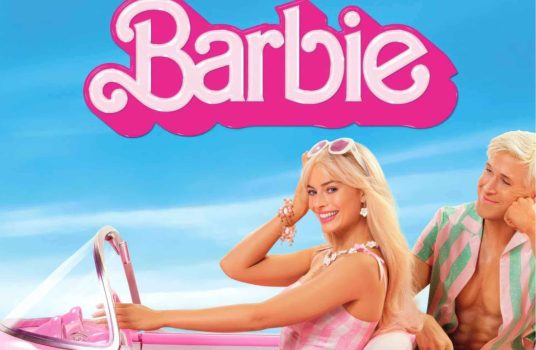Writing Lessons From... Barbie aka
Listen to the blogcast of this episode:
Okay, hands up, I admit it, it took me far too long to watch Barbie.
My excuse is that I refuse to go to the cinema these days, even for something so hyped up, especially for something so hyped up, and it’s only just appeared on a subscription service I actually have!
Finally! Finally, I’ve seen Barbie.
I laughed, I cried, I shouted ‘There’s bloody John Cena again!’ The man gets everywhere.
I could talk here about the overall themes in Barbie, the commentary on patriarchy and misogyny, but it’s all been covered in such depth elsewhere that I can’t be bothered.
Instead, I want to talk about the bits that really stuck out to me.
There are minor spoilers for Barbie ahead. Just in case you, like me, have taken ages to watch it
(However, Barbie is available now on Prime, if you have that!)

The general concept of Barbie is that Stereotypical Barbie (played by Margot Robbie), and all the other Barbies live in Barbieland, with Ken (played by Ryan Gosling – like you need me to tell you these things), all the other Kens, and Alan.
Stereotypical Barbie, however, must venture to the real world when she starts having thoughts about (gulp) death and whatnot, suggesting that there’s something very wrong with the little girl playing with her.
There’s a beauty to the worldbuilding in Barbie and I think that’s where my thoughts are headed for this one.
The idea that there’s a Barbieland where all the dolls live, acting out their days, while in the real world they as dolls are being played with is a novel one.
It’s something that might be a little hard to get your head around. This isn’t the Lego Movie, with a nice twist at the end, or Toy Story where there are clear boundaries between how the toys interact with our world.
This is made most apparent when Barbie goes to the real world, with Ken in tow. By car, boat, rocket and finally roller skates, they travel to our world and we watch them do it.
There’s no line to cross, no obvious moment when the worlds change over. One minute she’s, presumably, a doll and the next she’s a real woman. Or at least, a doll who looks like a real woman, I guess, in the real world.
As I sat thinking about this, while Barbie commented on the fact that she didn’t feel safe and what a strange feeling that was for her (I did my best not to laugh bitterly out loud), I wondered about how the writers felt they could just say, ‘And then she’s in the real world.’
Are the themes in this movie so powerful, so important, that the finer storytelling details just don’t matter? Especially as the whole concept involves such a leap in imagination – there being a Barbieland and a real world existing side by side.
That sounds a little sarcastic, but I really mean it in a nice, curious way, because the transition between worlds works really well. It’s in-keeping with the style of the film and glossing over the mechanics means it isn’t complicated where it doesn’t need to be.
While we’re talking about not complicating things…
The silliness of moving from one world to another is echoed in the movements and actions of the Mattel board – all men, which Barbie is disappointed by, and led by CEO Will Ferrell.
Ferrell is obviously a god when it comes to this kind of silliness, and the way the board members act, talk and run all match with the uncomplicated silence of the world transitions. Are these people really human?
What it actually is, I think, is a great PR stunt. When making a film about Mattel’s biggest toy line, you can draw awareness to their mistakes (a pregnant Barbie! A Barbie whose breasts grow bigger!!), but you can’t make them the bad guys.
But they sort of need to be the bad guys to a certain extent – they want to put Barbie back in her box and for good reason. That reason being profit. Because, capitalism.
Except they’re the big real-life guys in charge, they’re giving permission for this film to be made. There’s only so much you can do when treating them as the villains. So, instead, let’s make them silly and almost superfluous.
Which actually ties in nicely with the overarching themes of the patriarchy. This isn’t a film about men, but men affect women in every single way of life. The male Mattel board have to exist but let’s not inflate their importance here.
What’s important is the woman who created Barbie. Because in this film, what’s important is the women and how they view and are viewed in their world.
Damn it, this became about the themes of Barbie, didn’t it. For some reason I honestly thought I could write about the silly aspects of this film and why they worked so well as worldbuilding concepts without mentioning the patriarchy.
But here we are.
Turns out that Barbie is a story about women existing in a patriarchy, so even the silly or uncomplicated aspects are connected to that major theme. When worlds are built to show a matriarchy and the patriarchy, the themes are reflected in the world building, and therefore the silliness.
And maybe that’s the real writing lesson. You can soften the blow, you can ignore the trivial bits that don’t need explaining, but when well written, every aspect of the story can usually be tied back to the main message and theme of the story.
Which is sort of mind blowing, isn’t it?
It makes me want to go back and revisit other stories… I bet a lot of them do it. The next step, of course, is to revisit your own stories.
Do random little aspects of your stories tie back to the major theme? Should they? Could they?
Do you even have a major theme? Do you need one?!
Just something to think about while playing the Barbie soundtrack turned up loud.


